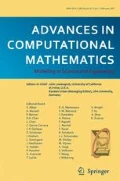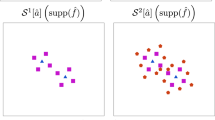Abstract
We construct A‐stable and L‐stable diagonally implicit Runge–Kutta methods of which the diagonal vector in the Butcher matrix has a minimal maximum norm. If the implicit Runge–Kutta relations are iteratively solved by means of the approximately factorized Newton process, then such iterated Runge–Kutta methods are suitable methods for integrating shallow water problems in the sense that the stability boundary is relatively large and that the usually quite fine vertical resolution of the discretized spatial domain is not involved in the stability condition.
Similar content being viewed by others
References
L.A. Bales, O.A. Karakashian and S.M. Serbin, On the A0-acceptability of rational approximations to the exponentional function with only real poles, BIT 28 (1988) 70-79.
K. Burrage, A special family of Runge-Kutta methods for solving stiff differential equations, BIT 18 (1978) 22-41.
J.R. Cash, On the integration of stiff systems of O.D.E.s using extended backward differentiation formulae, Numer. Math. 34 (1980) 235-246.
C. Eichler-Liebenow, P.J. van der Houwen and B.P. Sommeijer, Analysis of approximate factorization in iteration methods, Appl. Numer. Math. 28 (1998) 245-258.
E. Hairer and G.Wanner, Solving Ordinary Differential Equations II. Stiff and Differential-Algebraic Problems (Springer, Berlin, 1991).
P.J. van der Houwen, B.P. Sommeijer and J. Kok, The iterative solution of fully implicit discretizations of three-dimensional transport models, Appl. Numer. Math. 25 (1997) 243-256.
P.J. van der Houwen and B.P. Sommeijer, Factorization in block-triangularly implicit methods for shallow water applications, Report MAS R9906, CWI, Amsterdam (1999, submitted for publication).
P.J. van der Houwen and B.P. Sommeijer, Order reduction effects in approximate factorization (1999, in preparation).
S.P. Nørsett, Semi-explicit Runge-Kutta methods, Report Mathematics and Computation No. 6/74, Department of Mathematics, University of Trondheim (1974).
S.P. Nørsett and A. Wolfbrandt, Attainable order of rational approximations to the exponential function with only real poles, BIT 17 (1977) 200-208.
B.P. Sommeijer, The iterative solution of fully implicit discretizations of three-dimensional transport models, in: Parallel Computational Fluid Dynamics-Development and Applications of Parallel Technology, eds. C.A. Lin, A. Ecer, P. Fox, J. Periaux and N. Satofuka, Proceedings of the 10th Int. Conf. on Parallel CFD, May 1998, Hsinchu, Taiwan (Elsevier, Amsterdam, 1999) pp. 67-74.
B.P. Sommeijer, W. Couzy and P.J. van der Houwen, A-stable parallel block methods for ordinary and integro-differential equations, Appl. Numer. Math. 9 (1992) 267-281.
C.B. Vreugdenhil, Numerical Methods for Shallow-Water Flow (Kluwer, Dordrecht, 1994).
Author information
Authors and Affiliations
Rights and permissions
About this article
Cite this article
van der Houwen, P., Sommeijer, B. Diagonally implicit Runge–Kutta methods for 3D shallow water applications. Advances in Computational Mathematics 12, 229–250 (2000). https://doi.org/10.1023/A:1018969203026
Issue Date:
DOI: https://doi.org/10.1023/A:1018969203026




